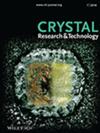Influence of Geometric Structure and Feeding Behavior of Casting on Freckle Formation during Directional Solidification of a Ni‐Based Single‐Crystal Superalloy
IF 1.9
4区 材料科学
Q3 CRYSTALLOGRAPHY
引用次数: 3
Abstract
Determining the effect of casting geometric structure on freckle formation is important in designing the directional solidification parameter of single‐crystal superalloy castings. In this research, single‐crystal castings of a third‐generation nickel (Ni)‐based superalloy with different thicknesses and structures are prepared by conventional Bridgman high‐rate‐solidification technique at withdrawal rates of 1, 3, and 6 mm min–1. The experimental results show that the freckles in castings with expansion structures are severer than those with contraction structures at a withdrawal rate of 1 mm min–1, and vice versa at withdrawal rates of 3 and 6 mm min–1. It is found that the larger casting thickness tends to promote the freckle formation at the same withdrawal rate. Furthermore, a lower tendency is displayed at the withdrawal rate of 3 mm min–1 in freckle formation, whereas an increased tendency is displayed at the withdrawal rate of 6 mm min–1. The different withdrawal rates, thicknesses, and structures of casting cause differences in cooling rate, shrinkage flow, and mushy zone morphology, which are believed to be responsible for the tendency of freckle formation.铸件几何结构和喂入行为对Ni基单晶高温合金定向凝固中雀斑形成的影响
确定铸件几何结构对裂纹形成的影响对设计单晶高温合金铸件定向凝固参数具有重要意义。在本研究中,采用传统的Bridgman高速凝固技术,以1、3和6 mm min-1的拉伸速率制备了具有不同厚度和结构的第三代镍基高温合金单晶铸件。实验结果表明,在抽吸速率为1 mm min-1时,膨胀结构铸件的雀斑比收缩结构铸件的雀斑严重,抽吸速率为3和6 mm min-1时则相反。结果表明,在相同的拔模速率下,较大的铸件厚度有利于雀斑的形成。此外,当停药速率为3 mm min-1时,雀斑形成的趋势降低,而当停药速率为6 mm min-1时,雀斑形成的趋势增加。不同的提取速率、厚度和铸件结构导致冷却速度、收缩流动和糊状区形态的差异,这被认为是造成雀斑形成趋势的原因。
本文章由计算机程序翻译,如有差异,请以英文原文为准。
求助全文
约1分钟内获得全文
求助全文
来源期刊
自引率
6.70%
发文量
121
审稿时长
1.9 months
期刊介绍:
The journal Crystal Research and Technology is a pure online Journal (since 2012).
Crystal Research and Technology is an international journal examining all aspects of research within experimental, industrial, and theoretical crystallography. The journal covers the relevant aspects of
-crystal growth techniques and phenomena (including bulk growth, thin films)
-modern crystalline materials (e.g. smart materials, nanocrystals, quasicrystals, liquid crystals)
-industrial crystallisation
-application of crystals in materials science, electronics, data storage, and optics
-experimental, simulation and theoretical studies of the structural properties of crystals
-crystallographic computing

 求助内容:
求助内容: 应助结果提醒方式:
应助结果提醒方式:


